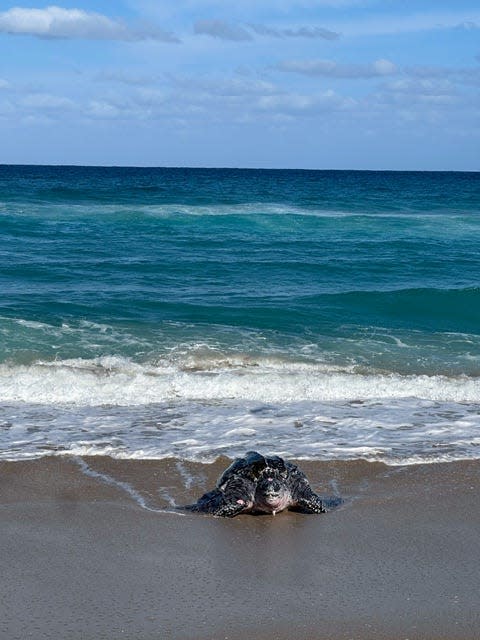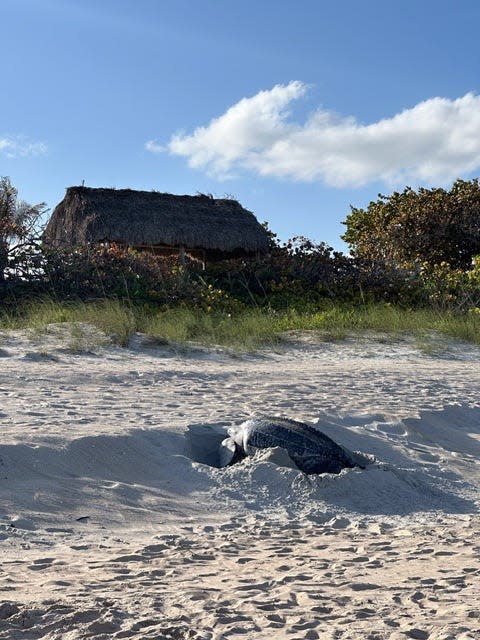"Like winning the lottery." Palm Beach woman sees leatherback turtle lay eggs during the day
Veronica Baruffati walks the stretch of sand on the southern end of Palm Beach every day, from her part-time Florida home north past Sloan’s Curve and back again.
What she saw while walking that beach on March 19 stunned her, and interrupted her normally uneventful evening sojourn.
With the sun still shining about 5 p.m. that day, Baruffati watched as a leatherback sea turtle emerged from the Atlantic Ocean and made its way to the dune, where it began to meet its seasonal imperative to create a nest and lay eggs.
Over the next two hours, Baruffati would get acquainted with Honeybee, a leatherback sea turtle first tagged by Juno Beach-based Loggerhead Marinelife Center in 2020, as the creature made its nest and then returned to the sea.
“It was really quite something,” said Baruffati, who stood at a distance and took photos as the turtle made its nest. “It was just pure luck. If I’d not been walking at that time, I might have missed the whole thing.”
There weren’t many people on the beach at that time, and the few who were there cleared out as dinnertime approached, she said.
Seagulls circled above as the massive leatherback slowly reached the dune and began digging, Baruffati said. The sky was clear. The air had an early spring chill.
“The timing couldn’t have been better,” Baruffati said of coming upon the turtle. “It was just amazing.”
Sea turtle researchers say these daytime nest creations are not especially rare — “It happens,” one said — but it is rare to witness them.

“We don’t get a lot of daytime nesting animals, and it’s always super exciting,” said Christine Perretta of D.B. Ecological Services, which is contracted by Palm Beach to monitor sea turtle nesting in the town. “It’s like winning the lottery to be able to see one of these animals nest during the day.”
The lifeguard on duty contacted D.B. Ecological, which responded to the beach along with Florida Leatherbacks Inc. and Loggerhead Marinelife Center, two other local sea turtle rescue and research organizations.
The researchers on the beach identified the sea turtle via a metal tag on her flipper as Honeybee, who was first tagged by Loggerhead on June 14, 2020, in Juno Beach, said Sarah Hirsch, Loggerhead’s director of research.
“They’re the least common sea turtle that’s found nesting on Florida’s beaches, so we get really excited when we see them here,” she said. Florida is the only state in the continental United States where leatherbacks nest, and about 50% of those nests are created on Palm Beach County beaches, according to the Florida Fish and Wildlife Conservation Commission.
Honeybee was spotted by Loggerhead again on July 14 and July 28, 2020, Hirsch said. Leatherbacks nest anywhere from eight to 11 times per nesting season, which started March 1 and runs through the end of October. Adult leatherbacks can weigh 700 to 2,000 pounds and measure 4 to 8 feet in length, the FWC said.
Monitors reported 574 leatherback nests in Palm Beach County last year, second only to Martin County, where 629 leatherback nests were counted, according to the FWC. There were 1,648 leatherback nests counted statewide, the FWC said.

Along with the metal flipper tag, Honeybee has an internal tag called a passive integration transponder, or PIT, similar to the microchips used in dogs and cats, Hirsch said.
The researchers worked with lifeguards to keep any onlookers at a safe distance, Perretta said. “Everybody was very excited and very respectful,” she said.
While Perretta wasn’t able to make it to the beach in time, her team members on site sent her eager updates throughout Honeybee’s nesting.
There’s no definite reason why some turtles nest during the day when most come onshore during night, Perretta said. “I kind of equate it to a woman in labor, or any other female species that’s in labor,” she said. “Sometimes I think they just have to go up and deposit those eggs at a particular time. They just have to do it.”
Those who come across a sea turtle nesting, whether during the day or at night, should keep their distance, stay quiet and stay out of the line of sight of the turtle, researchers said.
People also should remain downwind of the turtle, because an unfamiliar smell can disturb the turtle and cause it to go back to the water to find another place to nest, Perretta said.
Because it is sea turtle nesting season, it also is important for people to keep beaches clean, dark and flat, Hirsch said.
“That’s the way we like them for our sea turtles,” she said.
Palm Beach requires all oceanfront properties to shut off artificial lights from March 1 to Oct. 31 to protect sea turtles and hatchlings. Artificial lighting can confuse turtles and hatchlings and lead them away from the ocean instead of toward it, the town of Palm Beach said.
Nesting sea turtles can be reported to the Florida Fish and Wildlife Conservation Commission at 888-404-3922.
This article originally appeared on Palm Beach Post: Palm Beach woman watches leatherback sea turtle lay eggs in daytime
